Years ago our Irie had surgery on her right rear leg. She had TPLO (tibial plateau leveling osteotomy) surgery to stabilize her stifle (knee) joint, all due to a tear in the ACL (or known as CCL or cranial cruciate ligament in dogs). Whew…that’s a mouthful!
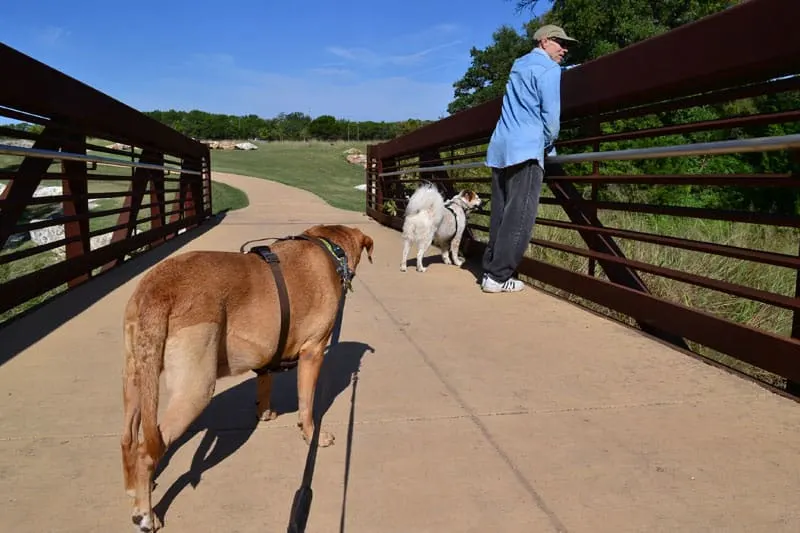
Irie spent just one night at the specialty hospital but the recovery period is long–12 weeks in all. Her surgery was in late August and she didn’t resume regular activity until after Thanksgiving.
So, in the meantime, we learned how to keep Irie happy and healthy, making what seem like baby steps toward her recovery. She had to be on leash any time she was outside and couldn’t jump or run at all. Our walks were super, super slow (think funeral march).
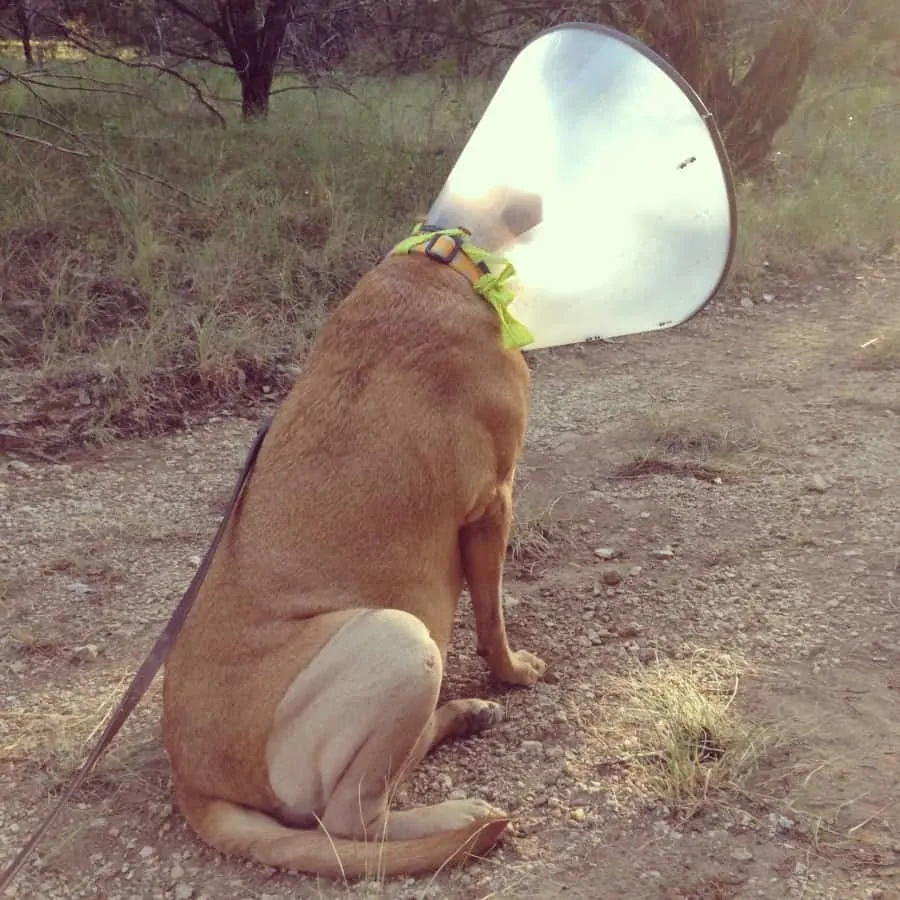
Here’s a look at tips we used as Irie recovered from ACL surgery:
1. Plan for very limited activity the first two weeks.
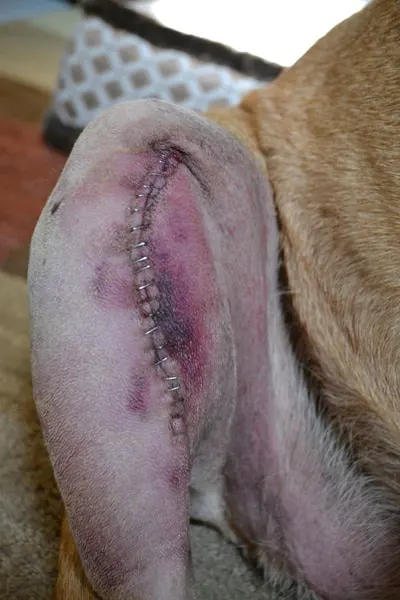
While Irie had surgical staples in place (and a cone around the clock), we did very little other than potty stops.
Brace yourself for the staples; I am a wimp about all things surgical so they were a bit of a shock at first.
The first thing I did was to take the photo above so I’d know if there were any changes that I needed to be concerned about; this gave me something to compare to if we thought we might see changes.
Once I got over the initial jolt, though, the staples really proved to be no issue at all. Irie couldn’t access them due to the cone.
And speaking of the cone, know that there are other models besides the one that is sent home with your dog after surgery. Irie wore a cone for two weeks as well. While we have some great soft post-surgery collars, we had to use a rigid collar per our discharge instructions; they were afraid Irie would be able to get through a soft collar.
We bought a clear Cardinal brand cone or e-collar so that Irie could have better peripheral vision. She seemed to really like this cone, with its padded neck, better than the one she was wearing at discharge.
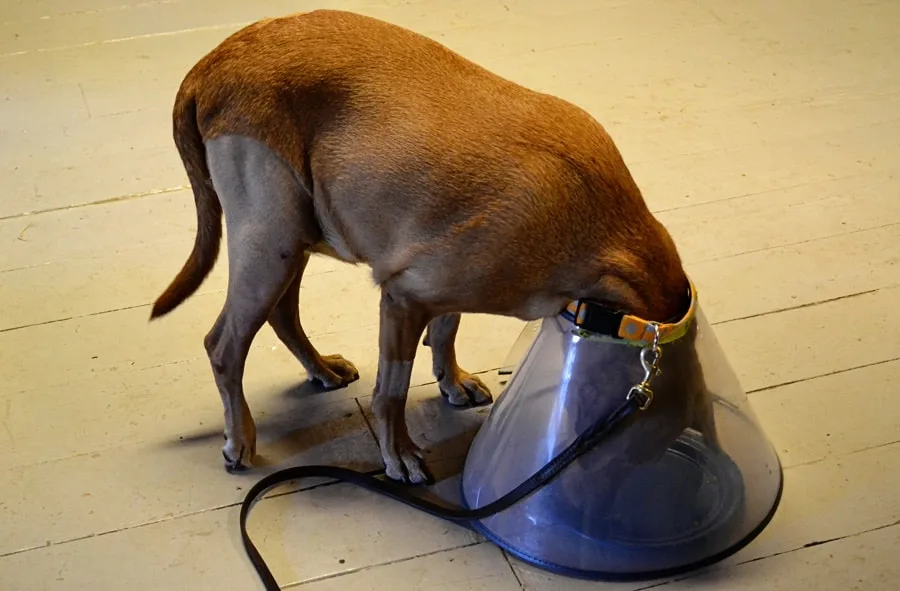
2. Consider a change in your sleeping arrangements.
If, like us, you sleep with your dog, you’ll need to make adjustments to your usual arrangements.
We moved our mattress directly onto the floor so Irie could get on the bed with us and rest comfortably. For the first several weeks, I kept her on leash in bed so I didn’t have to worry about her walking around the house in the night (which she never does anyway but I worry).
3. Consider a change in sitting arrangements.
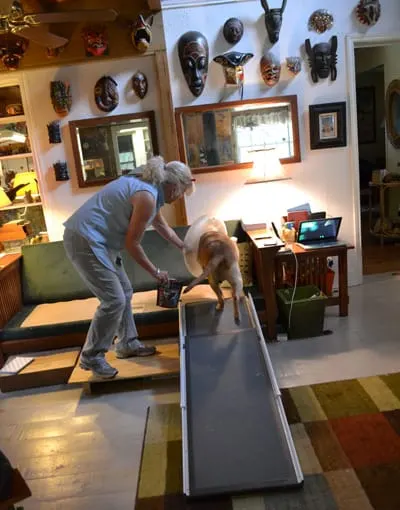
Typically Irie rested on the couch in the evenings. Since she could no longer get up on the couch, I removed all the cushions and sat them on the floor so we could sit there. John constructed a small step in front of the couch so Irie could get on the cushionless couch as easily as getting on our front porch, which the vet had cleared her to do. When we obtained a long ramp for the car, we started using it on the couch, too.
(No, we have not had any company during this recuperation period! And, yes, it looked about as good as you are imagining. But Irie was comfortable.)
Furniture that she could get on was removed from the house.
4. Plan to watch or crate your dog.
Fortunately, we both work at home so we were here with Irie around the clock. I have a laptop so, instead of working from my upstairs office, I worked downstairs with Irie.
5. Block all stairs.
The stairs up to our offices were blocked with baby gates. The cats could still get upstairs but we didn’t have to worry about Irie trying to go upstairs.
This was one of the most important changes we made because accessing those stairs could have been very dangerous after ACL surgery.
6. Sleep on leash.
For the first month, Irie slept with a leash clipped to her collar. I wrapped the leash around my arm so that, if she tried to get up in the night, she would awaken me.
7. Prevent boredom.
After about the first week, once the initial discomfort was gone, Irie grew bored.
When she was first released to begin activity again, Irie was only able to walk five minutes, twice a day. (We later worked up to two 25-minute slow walks.)
We used interactive toys to help distract her and stuffed a Kong with her meal, to help make her mealtime more challenging and longer lasting.
8. Walk dogs separately.
Since Irie had very, very limited activity in the first few weeks (and still walked extremely slowly), we walked our other dog Tiki separately. When Tiki came home from walks tired, it helped keep Irie calmer as well.
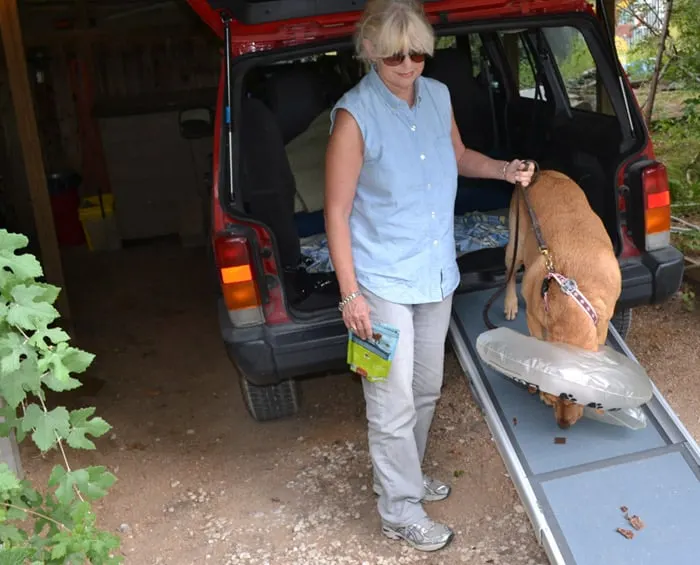
9. Schedule fun.
Irie loved to travel…but her overnight stay at the hospital meant that she was really reluctant the next time we headed to the car. She still had one more post-op appointment (for x-rays) but, the day after each vet visit, we try to schedule a fun day trip.
Since she was not able to ride for extended times in comfort, we planned mini day trips of just a couple of hours. We used an extended dog ramp for her to access the car safely.
After three months, her surgeon released her with no more follow-up visits unless we had concerns. She expected that Irie might continue to show improvement for as much as six more months.
We learned a lot about post-surgical recovery and, most especially, the importance of patience (which has not always been a strong suit of mine!) The recovery was slow but it was exciting to see the progress she made!
How Did Irie Hurt Her Cruciate Ligament?
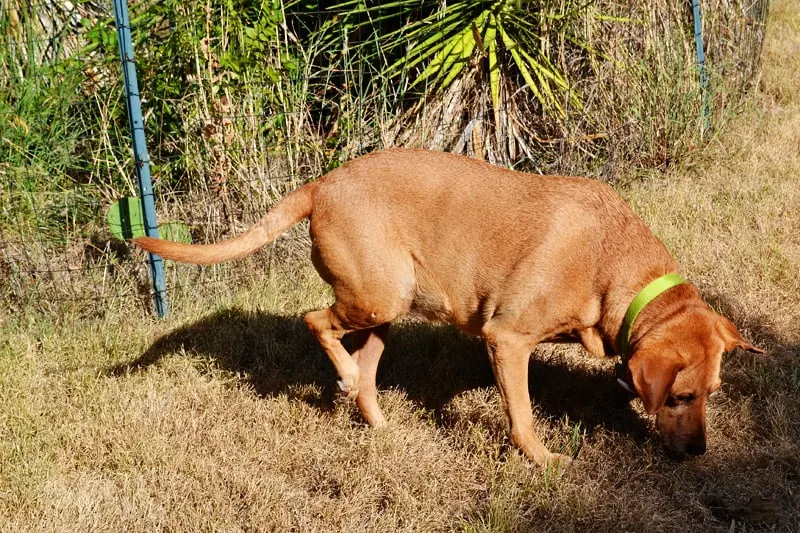
The morning of Friday, August 23 began like every other day. We got up, and we let the dogs outside to potty in the yard. Irie and Tiki were walking around, tending to business, when suddenly Tiki bolted for the back fence after a squirrel.
Irie took off after her…then we heard a yelp.
John and I both ran out to check on Irie. Honestly, we expected to see puncture marks from a snakebite.
We looked and looked, checking Irie for a bite. We saw nothing. She was holding up her rear right paw. OK, we figured that she’d stepped on a wasp, which had happened the week before. We headed back to the house, and put ice on Irie’s paw.
One hour went by and then two–but with no improvement. We realized it wasn’t a wasp sting so we called our vet to see if they could work us in. They said come on in.
As always, we brought along both dogs (Tiki’s presence really calms Irie at the vet). After a short wait, we got in to see the vet who quickly suspected a torn ACL. (As I mentioned, technically it’s CCL in dogs, or cranial cruciate ligament, but that’s like the ACL in humans.)
After a test for “drawer” movement, checking a back and forth sliding of the knee or stifle joint, and some x-rays, he confirmed that it was a tear and referred us to a local specialty vet hospital. Our vet also performed a full panel of blood work so we’d have that to take to the specialty hospital.
Of course, these things always seem to happen on a Friday, so, although we were able to make an appointment for Monday morning, we couldn’t get in to see the specialty vet until Monday. Over the weekend, we kept Irie as quiet as possible; our vet had also given us a prescription for pain killers to help make her more comfortable. During this time, she could only walk on three legs.
Off to Surgery
On Monday morning, we headed off to the surgeon’s office at the Central Texas Specialty Vet Clinic in Round Rock, a little over half an hour from our house.
We met with the surgeon who explained our surgical options for Irie. Because of her size (about 65 pounds), we selected TPLO or tibial-plateau-leveling osteotomysurgery. It involved, like the name suggests, leveling a portion of the tibia, basically cutting the bone and reconfiguring the geometry of the knee. It also includes a plate and screws.
We left Irie at the hospital that morning for sedation, detailed x-rays, then surgery.
Since the hospital didn’t like to worry about keeping up with blankets and toys, they don’t recommend leaving items with dogs but Irie is an anxious dog so I asked them to keep a cloth with her in her kennel. It was an old fleece sweater that I cut into a large square (so no arms for her to tangle in). I felt that the scent of home would be comforting to her (and it was comforting to me to leave her with something!)
We headed off with Tiki to go have some lunch at patio restaurant then hit a dog-friendly bookstore in Austin (both my birthday and Tiki’s gotcha day were right around the corner) then we all headed home to wait for word on Irie’s surgery and to prepare the house for her return home the next day.
By mid-afternoon, we had the call that the surgery had gone great, and Irie was awake.
Picking Up Irie After ACL Surgery
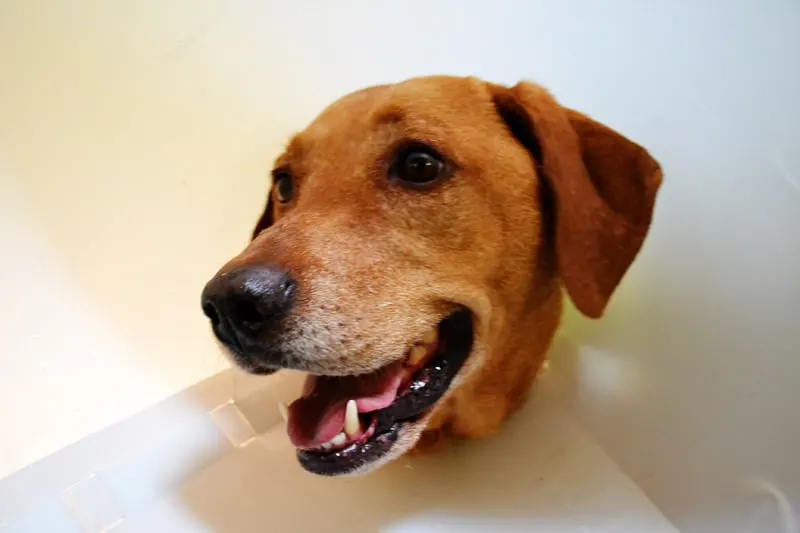
After what seemed an endless evening, we were at the clinic the next morning to pick up Irie. She came out in perhaps the largest cone I’ve ever seen. One of the techs helped us get her to and into the car. We’d prepared the car with a memory foam bed for her.
What we weren’t quite prepared for (even though we’d done a lot of reading on the subject), was the size of the incision, which was on the inside of her leg, was undressed, and included a long row of staples.
Once we got Irie home, we fed her a small meal and set about making her comfortable on the floor. She wasn’t to do any climbing so that meant no jumping on the bed or couch, her usual places to hang out during the day. And, since my office is upstairs, we’d closed off the stairs with a baby gate.
For the first night, we’d made a pallet of dog beds on the living room floor. We kept Irie on leash all day, going outside only for potty breaks. That night, I slept with her on the dog beds on the floor with her on leash to make sure she didn’t get up in the night. (I can now say, with complete honesty, that those memory foam dog beds are comfortable!)
The first two weeks of Irie’s recovery were the toughest due to the very strict restrictions during that time. She only went out for bathroom breaks, and remained on leash 24 hours a day. We’re so lucky that we both work at home so someone was always available to sit with Irie and keep an eye on her.
Rehab Begins
Week by week, we were able to add more time to Irie’s walks, which were done at the pace of a bride going down the aisle…step, step. She would have been happier to have gone faster but that meant hopping, so she had to be held back, at my side, and we slowly walked along. Tiki came along on our super slow, short walks, but she was walked separately as well.
As the weeks went by, we found our new normal–Irie spending the day beside me on the cushionless couch while I worked, taking Irie out on leash for all potty breaks, and taking super slow, short walks.
We soon decided that Irie needed to get back into our day trip routine so that she didn’t feel like she was going to the vet with every car trip, and we began enjoying short trips, first to parks in our hometown then longer half-day and finally full-day trips.
In mid-October, Irie went back in for follow-up x-rays, and we were happy to learn that her leg was 80 percent healed. By the end of October, we were able to go to the beach on our rescheduled summer vacation, and Irie was cleared to walk, on leash, as long as she’d like.
Once she was clear to resume her normal activities, we still took it easy, discouraging jumping (and the couch step remained in place for months, although the cushions have, thankfully, were returned).
And when I headed upstairs to start work in my office again, the first time in three months, we kept a careful eye on Irie, making sure she continues to build strength in her back leg so that she didn’t put stress on her rear left leg, which was a constant worry of ours (since roughly half the ACL surgeries are followed by surgery on the other leg).
Fortunately Irie never faced a reinjury or injury of her other rear leg!

This post was first published in 2014. Irie passed away four years later of spleen cancer–but in the remainder of her life she never had another problem with her ACL! She remained active and happy–and enjoying car rides–right up until the end!
Pin It to Remember It!
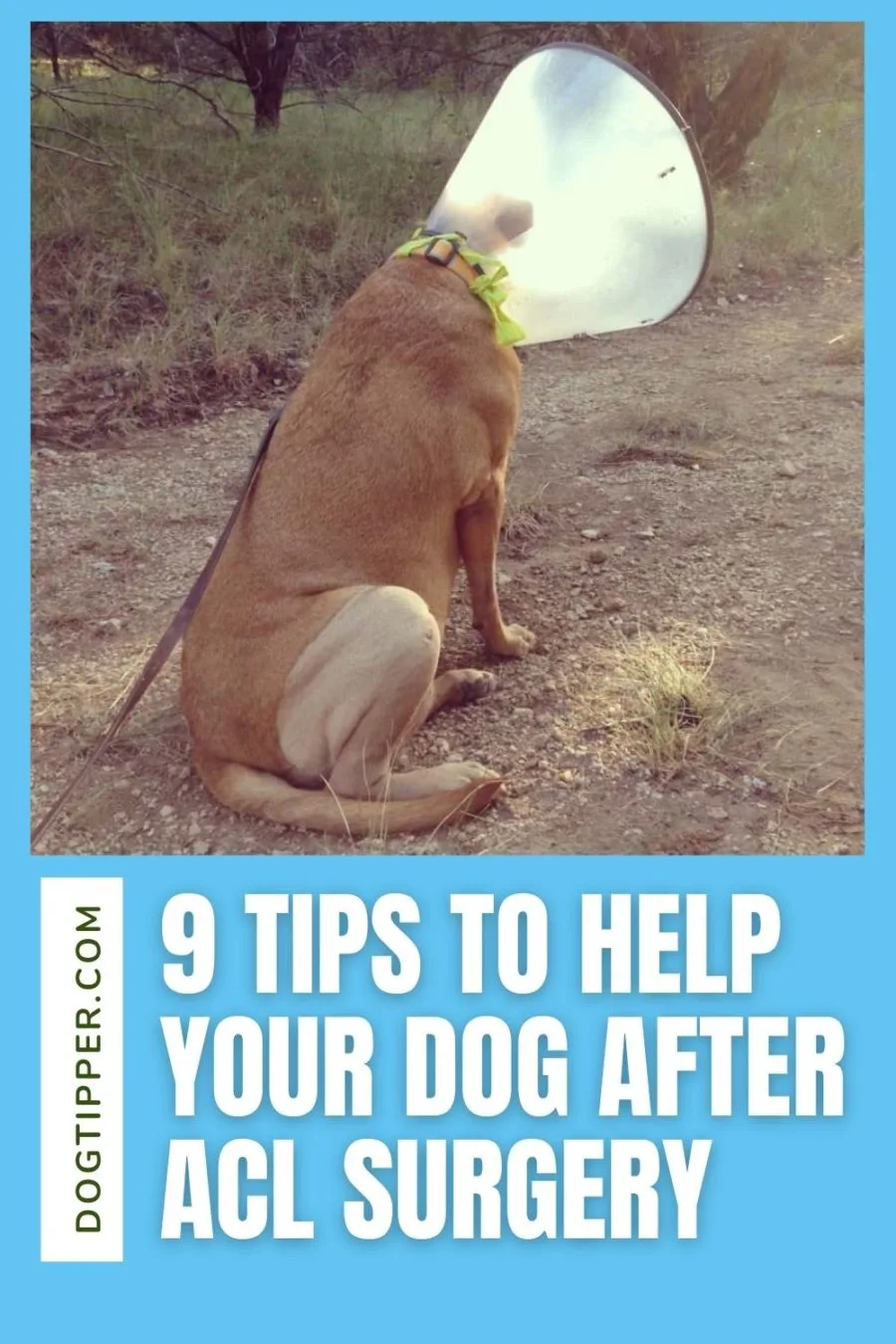
- Review: Jimmy BX7 Pro Anti-Mite Vacuum Cleaner - December 16, 2024
- 🎉 GIVEAWAY: Lord of the Pets Portrait of Your Dog! - November 26, 2024
- Review: Lord of the Pets Portraits - November 17, 2024
